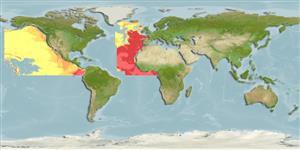Teleostei (teleosts) >
Lophiiformes (Anglerfishes) >
Linophrynidae (Leftvents)
Etymology: Linophryne: Greek, 'linon' = flax or anything made of flax such as "cord," "rope," or a "net" + Greek, 'phryne' = "toad" (refers to a toadlike fish that fishes with a net) (Ref. 86949).
More on authors: Regan & Trewavas.
Environment: milieu / climate zone / depth range / distribution range
Ecology
Marine; bathypelagic; depth range 210 - 1500 m (Ref. 86949). Deep-water
Eastern Atlantic: Known from a single record. Also known from a single record off the northeast coast of South America and one off California.
Size / Weight / Age
Maturity: Lm ? range ? - ? cm
Max length : 8.2 cm (female)
Short description
Identification keys | Morphology | Morphometrics
Dorsal soft rays (total): 3; Anal soft rays: 3. Metamorphosed females distinguished by the following characteristics: escal bulb without distal prolongation; single distal filament and series of about 10 branched filaments on each side; absence of anterior escal appendage; total length of barbel 25-33% SL, distal part with series of 5 photophores, proximal photophores set on short stalks; dense concentration of subdermal melanophores on caudal peduncle (Ref. 86949).
Also mesopelagic (Ref. 10762).
Life cycle and mating behavior
Maturities | Reproduction | Spawnings | Egg(s) | Fecundities | Larvae
Bertelsen, E., 1990. Linophrynidae. p. 516-519. In J. C. Quero, J. C. Hureau, C. Karrer, A. Post and L. Saldanha (eds.) Check-list of the fishes of the eastern tropical Atlantic (CLOFETA). JNICT, Lisbon; SEI, Paris; and UNESCO, Paris. Vol. 1. (Ref. 10762)
IUCN Red List Status (Ref. 130435)
Threat to humans
Harmless
Human uses
Tools
Special reports
Download XML
Internet sources
Estimates based on models
Preferred temperature (Ref.
123201): 3.1 - 4.3, mean 3.9 °C (based on 106 cells).
Phylogenetic diversity index (Ref.
82804): PD
50 = 0.5000 [Uniqueness, from 0.5 = low to 2.0 = high].
Bayesian length-weight: a=0.01000 (0.00244 - 0.04107), b=3.04 (2.81 - 3.27), in cm total length, based on all LWR estimates for this body shape (Ref.
93245).
Trophic level (Ref.
69278): 3.7 ±0.6 se; based on size and trophs of closest relatives
Fishing Vulnerability (Ref.
59153): Low vulnerability (10 of 100).
